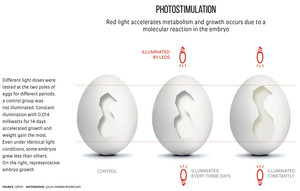 Red LED on fertilized chicken eggs hastened embryo growth by up to 25% and weight gain by 50%, according to a study by a group of researchers at the São Carlos Institute of Physics of the University of São Paulo (IFSC-USP). “Light accelerates metabolism in a molecular reaction,” explains physicist Vanderlei Bagnato, coordinator of the study and of the Optics and Photonics Research Center (CePOF), one of the FAPESP Research, Innovation and Dissemination Centers (RIDCs). “Poultry farmers already use light processes on farms to replace chickens in order to heat eggs in incubators, but what we propose, although it can be done in the same incubator, is different. They are light beams with a specific wavelength, that do not generate heat. The light stimulates the cells.”
Red LED on fertilized chicken eggs hastened embryo growth by up to 25% and weight gain by 50%, according to a study by a group of researchers at the São Carlos Institute of Physics of the University of São Paulo (IFSC-USP). “Light accelerates metabolism in a molecular reaction,” explains physicist Vanderlei Bagnato, coordinator of the study and of the Optics and Photonics Research Center (CePOF), one of the FAPESP Research, Innovation and Dissemination Centers (RIDCs). “Poultry farmers already use light processes on farms to replace chickens in order to heat eggs in incubators, but what we propose, although it can be done in the same incubator, is different. They are light beams with a specific wavelength, that do not generate heat. The light stimulates the cells.”
In an article published in the Journal of Biophotonics in July 2017, Bagnato and the dentist Cristina Kurachi, also a professor at UFSC, the postdoctorate researcher Hilde Buzzá and the master’s degree student Amanda Zangirolami used LEDs emitting light with a wavelength of 630 nanometers (nm) and a laser with a wavelength of 635 nm, positioned at the two poles of the eggs. The illumination was performed using fiber optic beams on fertilized eggs for 24 hours a day, over 14 days. “We used lasers, but you could use just LEDs,” says Bagnato. After testing several batches of eggs using different power settings, the best result was obtained with a dose of 0.014 milliwatts (mW) per square centimeter (cm2) of light per day. “It’s a very weak dose.”
In order for this process to be used in commercial poultry farming, further experiments will be necessary to study the development of the chicken embryo, so that it does not grow too fast and break the shell before the time is right. The embryo’s growth will have to be modulated, since the egg’s size does not change and the chick could begin to break the shell between 18 and 21 days. “We don’t want the embryo to grow too quickly, because it shouldn’t break through the shell until it is mature enough. In addition, the feathers grow at the end of the embryo’s life before breaking out of the shell,” says engineer Irenilza de Alencar Nääs, a professor who retired from the School of Agricultural Engineering at the University of Campinas (Feagri-Unicamp), and president of the Apinco Foundation of Poultry Science and Technology, in Campinas.
When commenting on the study, Nääs notes that there have been experiments with light used to incubate chicken eggs since 1975, in Israel. Also cited by Bagnato, these early studies used green light and growth increased by as much as 17%. “When they grew too much, the chickens had muscle and bone problems,” says Nääs. Another problem is that embryo growth under LED is not homogeneous, for reasons still unknown. Further studies are needed so that the results of the research can be made commercially viable. There is still no effective way, for example, to ensure that the up to 100,000 eggs that develop at the same time in an incubator are uniform in size and quality.
Sunlight and artificial light
“This is an open area of research, especially now with LEDs,” says the engineer. She notes that studies have shown that growing broilers prefer LED to fluorescent. “The birds become stressed and aggressive because they perceive the intermittent nature of the fluorescent light. When LED is used, the birds become calm because LED does not have this characteristic. The researcher believes that the study by Bagnato’s group makes important contributions to the subject because there is little information about the influence of artificial light on the embryos inside the eggs. “Birds are highly influenced by sunlight and artificial light, especially young birds. Lighting contributes to the growth of the chicken.” According to Nääs, the use of LED to stimulate embryo growth may produce effects, but she cautions that many studies will still be needed to see if bone growth is not overly affected.
Nor does Bagnato expect immediate application of the results of the study in poultry farming. The goal of this study, says the researcher, is to improve the phototherapy used for premature human infants. Similar to blue light therapy for the treatment of jaundice, a disease which leaves the newborn yellowish, he imagines that phototherapy might accelerate the development of babies born before nine months of gestation. “Since light accelerates metabolism, our hypothesis is that we can decrease the baby’s time in the incubator.” The physicist is continuing his studies, now with rats. “With mammals, we can induce premature labor, which is not possible with birds.”
Project
Optics and Photonics Research Center (CePOF) (No. 13/07276-1); Grant Mechanism Research, Innovation and Dissemination Centers (RIDC); Principal investigator Vanderlei Salvador Bagnato (USP); Investment R$28,014,802.21 (for the entire project).
Scientific article
Buzzá, H.H. et al. Photostimulation effects on chicken egg development: Perspectives on human newborn treatment. Journal of Biophotonics. Online in July 2017